|
The Restoration of
Kiss Me Deadlyby Glenn Erickson
An unusual thing happened ten years ago at Metro Goldwyn Mayer in Santa Monica: the missing ending to a 42 year-old United Artists Release Kiss Me Deadly was restored. The story does not involve a long vault search or a concerted effort by a film archive dedicated to such work. It appears that few people were even aware that a missing conclusion existed to be found. MGM certainly was unaware that their vaulted negative and all official prints were incorrect and that it had been distributing a mutilated version to revival houses and television stations for forty years. Not even experts Martin Scorsese and Bertrand Tavernier knew that they'd been watching an altered ending. Scorsese had just included Kiss Me Deadly in a compilation documentary about subversive films in the 1950s, with the incorrect conclusion.
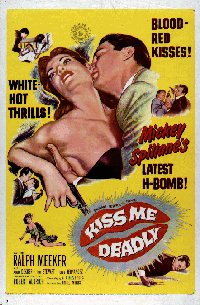
Kiss Me Deadly was released by UA with little fanfare on May 18, 1955. Robert Aldrich soon sold his interest in the film back to United Artists. In those days minor features would disappear from the public consciousness after a few weeks, and the violent Mickey Spillane detective saga entered the public record only when it topped the list of movies cited by the Kefauver Commission -- along with Horror Comics -- as contributing to the erosion of morals in America's youth. UA records show Kiss Me Deadly being added to, and then dropped from, various TV syndication packages starting in 1959. Did television stations object to the film's content immoral?
Kiss Me Deadly really didn't resurface in the cinema consciousness until the early 1970s when the French term film noir broke into American film journals. It suddenly appeared in a pantheon of top titles that included Double Indemnity, The Big Sleep, Touch of Evil and Out of the Past. Previously ignored as an irrelevant addendum to Mickey Spillane's culturally abhorred world of tough guy pulp fiction, Robert Aldrich and screenwriter A.I. Bezzerides' film was heralded as an extreme expression of protest against 1950s conformist complacency. It subverted Spillane by criticizing his brutal avenger Mike Hammer as greedy, narcissistic and infantile.
A key talking point with Kiss Me Deadly was its unique apocalyptic ending. Bezzerides replaced the original novel's coveted drugs with a bizarre secret kept in a Pandora-like steel box. Hoping to sell the box to the highest bidder, Mike Hammer (Ralph Meeker) tries to open it and is seared by a momentary blast of light and heat. Only afterwards is he told that the box is related to America's atomic energy program. The box is a door to the center of a nuclear reaction and, as indicated in the script's classical allusions, opening it will loose all of Pandora's evils into the world.
Kiss Me Deadly's femme fatale Lily Carver (Gaby Rodgers) can't resist finding out "What's in the box." The 1952 book ended in typically sadistic Spillane fashion. Carver shoots Hammer in the side, and invites him to kiss her before she kills him with a second shot. As she's naked and glistening with alcohol from a rubdown, Hammer instead ignites her with his cigarette lighter, and she goes up in flames. The movie ends at a stylish beach house in Malibu. The fully dressed Carver fells Mike with one shot from a .38, after making a similar invitation: "Kiss me Mike. Kiss me. The liar's kiss that says 'I Love You,' but means something else. You're good at giving such kisses." She then opens the box and turns into a pillar of fire, as her previous victim Dr. Soberin (Albert Dekker) had warned.
In the version most often seen from roughly 1960 to 1997, Hammer regains consciousness while Carver burns. He rescues his secretary Velda (Maxine Cooper) from a locked room and they limp arm-in-arm toward the exit. At that point we cut to a disconnected string of exterior shots. Light and smoke belch from the beach house. Several awkward jump cuts add superimposed explosions, as a miniature of the house breaks apart. A nondescript "The End" title appears, and the film fades abruptly -- not to black, but to gray leader. The music score and roaring sound effects overlap the ragged cut and then end with a poorly-timed fade.
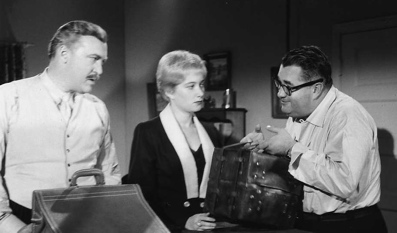
Critical analysis of Kiss Me Deadly from the 1980s and 1990s invariably accepted the abrupt ending as it stood. Some references applauded the chaotic finish as the element of Kiss Me Deadly that supposedly launched the French New Wave: the erratic jump cuts that infer that Velda and Mike never escape the flaming house. Many a film studies paper has pinned its premise to the assumption that the confused ending of Kiss Me Deadly depicts the End of the World, an event so extreme that even film logic breaks down.
Actually, if the Internet had been around twenty years earlier, these film writers might have discovered earlier that something wasn't right with the ending of Kiss Me Deadly. Alain Silver and James Ursini in their books What Ever Happened to Robert Aldrich? and the Third Edition of Film Noir, an Encyclopedic Reference to the Film Style, 1 noted that critic Raymond Durgnat had referred to having seen a copy of Kiss Me Deadly in which Velda and Mike reach the safety (?) of the surf while the house burns. Robin Wood, however, was of the opinion that the producers had added such a shot at a later time. Silver also remembered noticing that several shots seemed to be missing when he examined a print of the film in the early 1970s. When Aldrich interviewers Edwin T. Arnold and Eugene L. Miller Jr. asked Aldrich about the issue, the director stated firmly that he'd never seen any version except his own, in which Hammer and his secretary escape to the ocean. 2
Alain Silver was always convinced that a correct, unchanged copy of Kiss Me Deadly should exist somewhere. I remember talking about the ending with Alain's frequent collaborator Jim Ursini at UCLA in 1974, when we worked in the Research Library's Theater Arts Reading room. Special Collections has a copy of the Kiss Me Deadly script, and its last page definitely states that Mike and Velda exit the house and make their way to the ocean.
Alain and I began discussing the issue in earnest in 1992 when I was working at MGM cutting video promos for VHS releases. I told him I had seen the film several times in 35 and 16mm and was convinced that the ending had been altered. My hasty guess was that a film handler had damaged the original negative, and the ending had been cobbled together to hide the mistake. 3 MGM had just released Kiss Me Deadly on home video for the first time. The laser disc included a trailer that contained a shot of Velda trying to steady the wounded Mike Hammer as they floundered in the Malibu surf.
Nothing more happened for four years. Alain wrote more about Kiss Me Deadly and Robert Aldrich. In the meantime, I met John Kirk, a Technical Services Special Projects Director at MGM. John frequently took on restoration projects requiring research, especially with foreign films. John restored a longer ending to Louis Malle's ¡Viva Maria! and recovered thirteen minutes that had been trimmed from Francois Truffaut's Mississippi Mermaid. He also solicited permission from Billy Wilder to restore his original uncensored cut of Kiss Me Stupid! and restored Sergio Leone's Duck You Sucker to its full original Italian length.
I showed John the Kiss Me Deadly trailer with the missing shot and told him the whole story. It was exactly his kind of problem. We began screening the last reels from vaulted prints of Kiss Me Deadly, with no results. John found and printed a box of trims, but they turned out to be alternate foreign language sequences for the French version, En quatrième vitesse (literally, "In Fourth Gear", i.e., "Going like hell").
About this time I found a translation of Francois Truffaut's original 1955 review of Kiss Me Deadly in Cahiers du Cinema. It stated, "As the hero and his mistress take refuge in the sea, THE END appears on the screen." That sounded hopeful. Perhaps the film had been released in two versions. But if the ending was intact in France, why was Bertrand Tavernier unaware of it?

Then Alain Silver called with a possible way of finding an uncut print. As a member of the Director's Guild, Alain had already accessed the Guild's film holdings for research and knew that Robert Aldrich routinely deposited personal prints of his films with them. The Guild's holdings were kept in reserve at the UCLA Film Archives and special permission was required for access.
Alain knew the Aldrich family and had no trouble obtaining their written consent. The Guild and the Archive had good relations with MGM, which was the sole owner of the 1955 UA picture. If MGM couldn't review its own film, who could?
Within a few days Aldrich's print was delivered to a screening room in the MGM Plaza. We were surprised when it came up looking rather scratched and battered. The ending was the same as ever. We thought we'd reached the end of the line until John determined that a clerk at the UCLA archive had misread the request and pulled an ordinary 35mm copy from the vault. One week later, the correct Aldrich archive reel arrived. It was immediately apparent that it was different. It was not only spotless, the photographic quality was better as well.
This time we practically fell out of our seats. At the point where standard prints cut to the ragged short ending, this copy continued into a completely new sequence. The couple descended some stairs and then took off across the beach. The shots of the burning house were now separated by four new angles with Velda and Mike throwing long shadows down the beach. Rear-projected views showed the pair in front of the exploding beach house. They watched from the surf until an authentic end title ("The End, A Parklane Picture") appeared. The mystery box growled and howled throughout at full volume, like the monster of a 50s Science Fiction film. The beautiful ending had more production value than anything else in the movie. Although it was disturbing, it was conventionally edited, and resembled nothing that would inspire the French New Wave. Truffaut and Co. must have been taken by the film's overall anarchic sensibility.
The new sequence lengthened the film by 65 seconds. Realizing that it was a major find, John Kirk decided not to re-screen the reel but instead sent it directly to the lab. A dupe made from it matched the rest of the negative perfectly. Knowing the significance of the discovery, John solicited quotes from Scorsese and Tavernier to use in his screening publicity. Neither claimed any earlier knowledge of the full ending.
Kiss Me Deadly was the revival and restoration hit of August 1997, packing audiences into the Los Angeles County Museum of Art and the New Beverly Theater. John Kirk took a print with him when he toured festival screenings that fall. MGM Home Video responded to the publicity and issued a restored VHS. The film happened to be a personal favorite of one of the executives, who told me that he preferred the old, truncated cut.
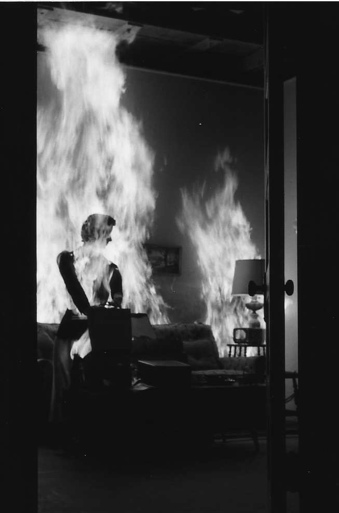
There remained a nagging question. We were now certain that Kiss Me Deadly had at some point been subjected to an editorial mutilation, but we didn't know why. After the L.A. Times ran a lengthy article on the restoration in its Calendar section 4 I received a call in my MGM cutting room from Robert H. Justman, Robert Aldrich's assistant director on the film. Justman, who later produced TV seasons of The Outer Limits and Star Trek, called to tell me that he hadn't seen the film since it was new either, and had no idea that the ending had been cut. Unfortunately, Mr. Justman wasn't interested in discussing the many noir thrillers that he'd worked on in the early 1950s.
But Justman inspired me to try to contact the writer A.I. Bezzerides, who lived in Southern California. In two very illuminating phone calls Bezzerides told me that he'd purposely turned Kiss Me Deadly into a critique of the entire Mickey Spillane ethos. He invented the idea of an atomic secret to replace the book's shipment of drugs, as the censors wouldn't allow movies about drug trafficking. The classical allusions and the apocalyptic finale were also Bezzerides' idea, and he was pleased that Aldrich had kept them intact. In his mind, we leave Velda and Mike as they witness the beginning of the end of the world.
There was a kickback to our announcement that the ending of Kiss Me Deadly had been missing for 42 years. An attendee at the L.A. County Museum told me that he'd seen the ending at LA's Nuart theater not a year before. The Nuart had rented its print from MGM; I have to assume that they quietly screened a collector's copy instead. Because the original ending apparently still survived on some prints, I prepared an introduction for the video release that softened the claim. We said that Kiss Me Deadly had been 'predominantly seen' with the altered ending.
Much later in 2002, I was told that the DGA/UCLA print of Kiss Me Deadly had been screened ten times at New York's Lincoln Center in 1992. The news hadn't circulated very well, as even New Yorker Martin Scorsese remained unaware of the original ending, and articles continued to appear that discussed the 'old' ending. I felt like Dr. Strangelove asking why the Russians had kept the Doomsday device a secret: "Why didn't you tell the world, eh?" The New York film schedulers had not informed MGM of the problem. At the very least, they should have thought twice before projecting such a rare print ten times. Alain, John Kirk and I detected the uncut ending independently and made the restoration happen.
In the wake of the publicity surrounding the 1997 restoration I was granted access to UA legal records on Kiss Me Deadly to see if they would shed light on the mystery. I learned that Robert Aldrich's fee for directing was $25,000, but little more. When file boxes of photo negatives were retrieved from deep storage, I saw the very limited photo coverage UA had given the film in 1955. In the files were two documents that suggested a possible reason why United Artists had changed the ending.
The first letter was from the head of theatrical sales to his film bookers, the staff charged with getting UA pictures shown in theater chains across the country. The brief note stated that the executive was unhappy with bookings in the south, and wanted his men to redouble their efforts. It read like a 'cover one's tail' letter, an attempt to lay a paper trail establishing that the executive had done his job, and couldn't be blamed if bookings were low. The receipts for Kiss Me Deadly were indeed poor, much worse than the earlier UA Hammer films I, The Jury and The Long Wait.
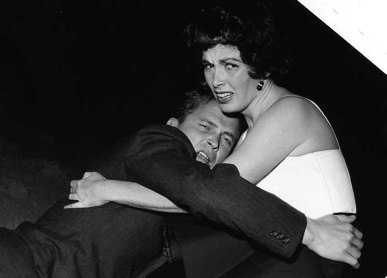
The second document was a carbon copy of an unpublished 1955 Robert Aldrich article intended for the trade papers and entitled In Defense of Sex and Violence. The director expresses his dismay over the distribution of his newest film (never named) which had been unofficially locked out of most the large southern market by a particular minister who was serving as sort of a clearing house censor, Lloyd T. Binford. To avoid submitting their films to every municipality and parish, the studios had a tacit agreement to allow Binford to be the sole judge of what could or couldn't be shown across several southern states. Aldrich fulminated at the idea that he could work a year to qualify a film for a Seal of Approval from the Production Code office, only to have some kingpin in Tennessee block its distribution and render it unprofitable. Aldrich called for studios to band together against this artistic blackmail, instead of rushing to fill the distribution gap with their own product.
The two documents suggested another theory. The end of Kiss Me Deadly had been purposely altered. The only result of that alteration content-wise was to make it appear that Mike Hammer, a man established as less than virtuous, died at the end. Is it too farfetched to imagine that a UA executive, hoping to get Kiss Me Deadly shown in the south, secretly ordered the change to the ending to pacify the conservative minister-censor? The alteration must have done in secret because Robert Aldrich would certainly never have approved. The crude way the film was changed indicates that a minimal effort and expense was involved. It wasn't simply a change for television because all the 35mm elements had been altered as well. Whoever at United Artists decided to butcher the original negative instead of a duplicate must have been a real Philistine.
Although it's only an educated guess, that's the best theory I've come up with to explain what happened to Kiss Me Deadly in 1955. An accident covered up by a film clerk doesn't sound possible, because somebody had to order the cheap 'The End' title. If the movie was indeed changed to placate censors, it was a clear case of money versus artistic integrity, and we all know the answer to that Hollywood story. Restorations of this kind are soon forgotten; even the Turner Classic Movies cable channel no longer mentions that the film was ever different. And film students reading the old literature about an anarchic, deconstructed conclusion that inspired Francois Truffaut and Jean-Luc Godard will soon be wondering what the writers were talking about.
Footnotes:
1. Alain Silver and Jim Ursini, What Ever Happened to Robert Aldrich?: His Life and His Films 1995 Limelight Editions New York.
Alain Silver and Elizabeth Ward, editors, Film Noir: An Encyclopedic Reference to the American Style Overlook Press, Woodstock New York
Return
2. Edwin T. Arnold and Eugene L. Miller, The Films and Career of Robert Aldrich 1986, University of Tennessee Press, Knoxville
Return
3. I repeated that 'guess' in my article The Kiss Me Mangled Mystery for the online 'zine Images in 1997. The theory lacks an explanation for why the shots of the house weren't damaged as well, and also doesn't explain the optical of the 'The End' card.
Return
4. Bill Desowitz, Cult Classic Mystery L.A. Times Calendar, August 12, 1997.
also, Paul Malcolm, The Big Bang Theory: How Robert Aldrich's classic film noir, Kiss Me Deadly, got its ending back LA Weekly August 15-21, 1997.
Return
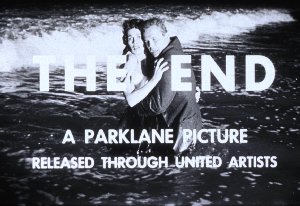
Links:
The first publication of this article at the Film Noir of the Week site, July 13, 2007. See the two separate endings!
Savant's 2001 review of the Kiss Me Deadly DVD.
Savant's original 1997 Kiss Me Deadly restoration article.
Alain Silver's original 1996 speculative article So What's With the Ending of Kiss Me Deadly? from the Images site.
Savant's original 1997 Images restoration article, The Kiss Me Mangled Mystery.
Text © Copyright 2007 Glenn Erickson
DVD Savant Text © Copyright 2007 Glenn Erickson
Go BACK to the Savant Main Page.
Reviews on the Savant main site have additional credits information and are more likely to be updated and annotated with reader input and graphics.
Return to Top of Page
|












